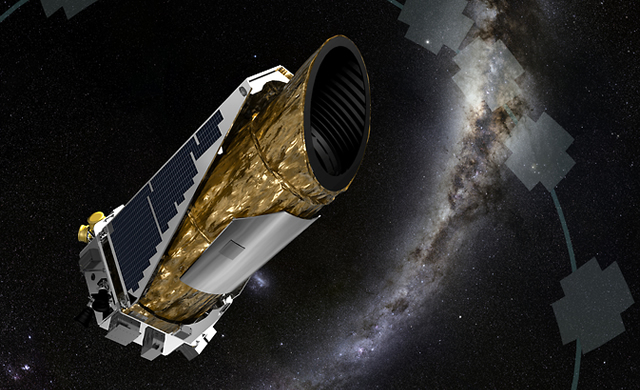
Image Credit: NASA Ames/JPL-Caltech/T Pyle
Il famoso “cacciatore” di pianeti Kepler è ritornato operativo e ha subito scoperto un nuovo esopianeta, il primo trovato con la nuova missione K2. La scoperta è avvenuta mentre astronomi e ingegneri stavano ancora lavorando per rimetterlo in funzione per la seconda missione denominata K2, sempre alla ricerca nel cosmo di altri mondi.
“La scorsa estate, la possibilità per una nuova missione scientificamente produttiva, dopo i problemi e il fermo della sonda, non era neppure immaginabile. Di prolungare la missione non se ne parlava nemmeno,” riferisce Paul Hertz, astrofisico della NASA e direttore della divisione del quartiere generale a Washington. “Oggi, grazie ad un’idea innovativa e al duro lavoro svolto dai team della NASA e della Ball Aerospace, Kepler ha rilevato i primi candidati per gli studi che tramite il Telescopio James Webb cercheranno di svelare le caratteristiche delle atmosfere di questi mondi lontani, alla ricerca di segni di vita. Il capo ricercatore Andrew Vanderburg, uno studente laureato presso il Centro Harvard-Smithsonian per l’Astrofisica di Cambridge, nel Massachusetts, ha studiato i dati pubblici a disposizione raccolti dalla sonda durante una test della nuova missione, nel febbraio 2014. La scoperta è stata confermata con misure prese dallo spettrografo HARPS-Nord del Telescopio Nazionale Galileo alle Canarie, che ha catturato l’oscillazione della stella causata dalla forza gravitazionale del pianeta che le orbita attorno. 116454b, recentemente confermato pianeta HIP, è 2,5 volte il diametro della Terra, ha un periodo orbitale di 9.1 giorni e orbita a circa 13.5 milioni di km dalla sua stella, che è più piccola e più fredda del nostro Sole, praticamente 11 volte più vicino della distanza Terra-Sole, rendendo il pianeta troppo caldo per la vita come noi la conosciamo. HIP 116454b e la sua stella si trovano a 180 anni luce dalla Terra, verso la costellazione dei Pesci.
NASA’s planet-hunting Kepler spacecraft makes a comeback with the discovery of the first exoplanet found using its new mission K2. The discovery was made when astronomers and engineers devised an ingenious way to repurpose Kepler for the K2 mission and continue its search of the cosmos for other worlds.
“Last summer, the possibility of a scientifically productive mission for Kepler after its reaction wheel failure in its extended mission was not part of the conversation,” said Paul Hertz, NASA’s astrophysics division director at the agency’s headquarters in Washington. “Today, thanks to an innovative idea and lots of hard work by the NASA and Ball Aerospace team, Kepler may well deliver the first candidates for follow-up study by the James Webb Space Telescope to characterize the atmospheres of distant worlds and search for signatures of life.” Lead researcher Andrew Vanderburg, a graduate student at the Harvard-Smithsonian Center for Astrophysics in Cambridge, Massachusetts, studied publicly available data collected by the spacecraft during a test of K2 in February 2014. The discovery was confirmed with measurements taken by the HARPS-North spectrograph of the Telescopio Nazionale Galileo in the Canary Islands, which captured the wobble of the star caused by the planet’s gravitational tug as it orbits. The newly confirmed planet, HIP 116454b, is 2.5 times the diameter of Earth and follows a close, nine-day orbit around a star that is smaller and cooler than our sun, making the planet too hot for life as we know it. HIP 116454b and its star are 180 light-years from Earth, toward the constellation Pisces.
Source/Continue reading → www.nasa.gov






















Pingback: Buon Compleanno, Kepler! – Happy Birthday, #Kepler! | DENEB Official ©
anch’io sono appassionato e affascinato dal lavoro di Kepler, speriamo di ricevere nuovi risultati presto.
complimenti per il sito.
Andrea
Grazie Andrea, aspettiamoci molto altro!
Giusto qualche giorno fa pensavo a Kepler e a quanto mi mancassero le sue strepitose scoperte!
Ciao Deneb! Bella questa cosa, sembrate proprio in sintonia!!
Ho saputo di questi pianeti grazie al tuo sito, prima non ne sapevo proprio niente!
Buona giornata e buon lavoro :)
Bea
Ciao Bea, buongiorno :)
Grazie, mi fa piacere!
E sì, sembra proprio che siamo in sintonia, un amore di lunga data e corrisposto!! ;-))